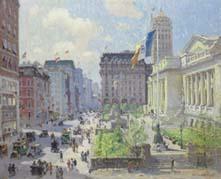Artist Profile
Colin Campbell Cooper
- Lived:
- 1856-1937
- Worked:
- California, New York
- Style:
- Landscape, Cityscape, Still Life, Portrait
Colin Campbell Cooper, painter, teacher, writer, lecturer, watercolorist and impressionist was born in Philadelphia, P.A. in 1856. His father, a wealthy surgeon, encouraged his son to pursue his talent in art. He was also inspired by the art he saw at the 1876 Philadelphia Exposition. He studied at the Pennsylvania Academy of the Fine Arts with Thomas Eakins, the Academies Julian in Paris with Vitti, and Delecluse and additionally at other art schools in Paris. He spent much time in Europe painting figure and architectural subjects, many of these paintings were lost in a fire of 1896. Architecture and street scenes became his specialty.
Mr. Cooper's notable achievement was his long series of canvases depicting the picturesque charm of the modern sky-scraper, particularly those of New York and Philadelphia; he began this work in 1902. It was said of these works, "He saw beauty, sublimity and grandeur in the structures that his average contemporary was wont to call monstrosities." He was also known for painting genre, portraits, Italy, Spain, interiors, harbors, churches, still lifes and flowers.
Colin Cooper was also known for the unique way that he handled watercolor on canvas, he did this "so cleverly that his water-colors can scarcely be distinguished from oils." This style of painting was later called "The California Style" of watercolor painting. Very few, if any, artists at the time were employing this technique in the manner that Cooper was. Speaking of the success that Cooper had in rendering his city scenes, a writer for the Brush and Palette (1872) magazine wrote "that Cooper has the natural gift of seeing the beauty of what to most people are prosaic structures, and the patience and persistence to perfect his delineation of street and building, is the secret of his success as an architectural painter."
The success that Cooper had in rendering these scenes was also due in part to the influence that the impressionist painter Frederick Childe Hassam had on him. He met Hassam in New York in the beginning of the 1890s and was influenced by the delicate handling and atmospheric qualities conveyed by Hassam's canvases.
From 1895 to 1898, Cooper was instructor of watercolor at the Drexel Institute in Philadelphia, and then moved to New York City from where he and his artist wife Emma Lampert traveled throughout the world in search of subject matter. One art critic stated: "Mr. Cooper recently returned from the Far East and has exhibited Indian paintings in New York. Among his architectural works which are said to possess such charm as to make them dreams of beauty are: Taj Mahal, Agra, White Mosque, Bombey, and Maharajah's Palace, Udaipor (Venice of India).
The Coopers first went to California in 1915, spending the winter in Los Angeles, and in 1921, settled in Santa Barbara, where he served as Dean of Painting at the Santa Barbara Community School of Arts. He also painted in Taos, New Mexico, and in Arizona including the Superstition Mountains east of Phoenix.
Cooper was a member of many leading art clubs in this country. He was elected an associate member of the National Academy of Design in 1908, and elected to full status as an Academician to the National Academy of Design in 1912. Additionally he was a member of the New York Watercolor Club; Art Club of Philadelphia; Philadelphia Watercolor Society; American Watercolor Society; Fellowship Pennsylvania Academy of Fine Art; Lotus Club; National Arts Club and American Federation of Arts and others.
He won numerous awards including: Wm. T. Evans prize, American Watercolor Society, 1903, 1910; gold medal for oil and silver medal for watercolor, Pan Am Pacific Expo., San Francisco, 1915; Hudnut prize, New York Watercolor Club, 1918, and others.
His work can be found in many important museum collections throughout the world.
Colin Campbell Cooper passed away in Santa Barbara, California on November 6, 1937.


